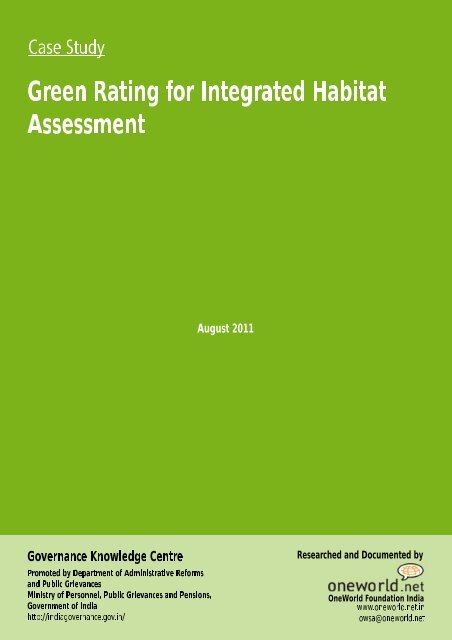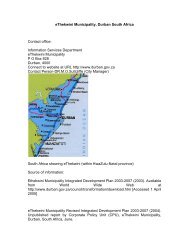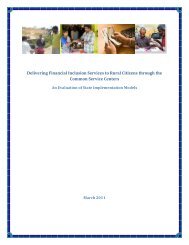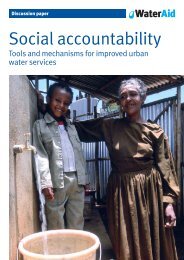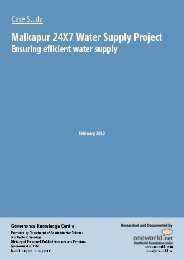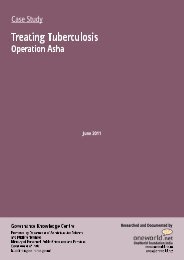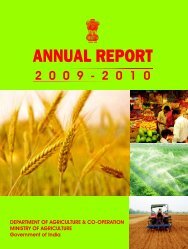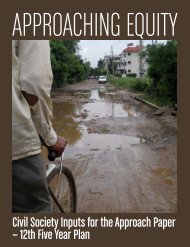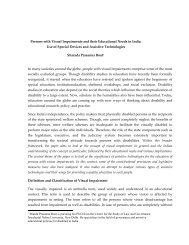See full case study - Indiagovernance.gov.in
See full case study - Indiagovernance.gov.in
See full case study - Indiagovernance.gov.in
- No tags were found...
You also want an ePaper? Increase the reach of your titles
YUMPU automatically turns print PDFs into web optimized ePapers that Google loves.
Green Rat<strong>in</strong>g for Integrated HabitatAssessmentAugust 2011Governance Knowledge CentrePromoted by Department of Adm<strong>in</strong>istrative Reformsand Public GrievancesM<strong>in</strong>istry of Personnel, Public Grievances and Pensions,Government of Indiahttp://<strong>in</strong>dia<strong>gov</strong>ernance.<strong>gov</strong>.<strong>in</strong>/Researched and Documented byOneWorld Foundation Indiawww.oneworld.net.<strong>in</strong>owsa@oneworld.net
Governance Knowledge CentrePromoted by Department of Adm<strong>in</strong>istrative Reforms and Public GrievancesM<strong>in</strong>istry of Personnel, Public Grievances and PensionsGovernment of IndiaCase StudyEnvironmental Susta<strong>in</strong>abilityGreen Rat<strong>in</strong>g for Integrated HabitatTRANSPARENCY AND ACCOUNTABILITYAssessmentAugust 2011Table of ContentsEXECUTIVE SUMMARY ................................................................................................................................ 2BACKGROUND ................................................................................................................................3OBJECTIVE ................................................................................................................................5WORKING DESIGN ................................................................................................................................5THE RATING SYSTEM .................................................................................................................................. 8PROJECT SCORING ........................................................................................................................... 10BENEFITS ................................................................................................................................10METHODOLOGY ................................................................................................................................13KEY STAKEHOLDERS ....................................................................................................................... 13LESSONS LEARNED ................................................................................................................................14REFERENCES ................................................................................................................................15APPENDIX A: INTERVIEW QUESTIONNAIRE......................................................................................... 151Researched and documented byOneWorld Foundation India
Governance Knowledge CentrePromoted by Department of Adm<strong>in</strong>istrative Reforms and Public GrievancesM<strong>in</strong>istry of Personnel, Public Grievances and PensionsGovernment of IndiaCase StudyEnvironmental Susta<strong>in</strong>abilityGreen Rat<strong>in</strong>g for Integrated HabitatTRANSPARENCY AND ACCOUNTABILITYAssessmentAugust 2011EXECUTIVE SUMMARYGreen Rat<strong>in</strong>g for Integrated Habitat Assessment (GRIHA) is a Government of India (GoI) rat<strong>in</strong>gsystem1 for green build<strong>in</strong>gs developed by The Energy and Resources Institute (TERI) <strong>in</strong>2004;Later, <strong>in</strong> 2007, the M<strong>in</strong>istry of New and Renewable Energy (MNRE) collaborated withTERI to form an <strong>in</strong>dependent society called ADARSH to develop and implement GRIHA. Thesociety’s responsibilities are to register projects under GRIHA, and also to advocate andgenerate awareness on susta<strong>in</strong>able habitats <strong>in</strong> the Indian context. All registered <strong>in</strong>stitutional,commercial and residential build<strong>in</strong>gs except <strong>in</strong>dustrial complexes are rated based on 34 criteriathrough the process of build<strong>in</strong>g design<strong>in</strong>g, construction, operations and ma<strong>in</strong>tenance. It is theonly rat<strong>in</strong>g system that covers ventilated, air conditioned and non-air conditioned build<strong>in</strong>gsystems.Based on nationally accepted energy and environmental pr<strong>in</strong>ciples, this <strong>in</strong>itiative supportsgreen susta<strong>in</strong>able habitats us<strong>in</strong>g m<strong>in</strong>imum renewable electricity consumption, ra<strong>in</strong> waterharvest<strong>in</strong>g and recycled waste materials that costs lesser than a conventional build<strong>in</strong>g withoutharm<strong>in</strong>g the environment. The environmental pr<strong>in</strong>ciples are adapted to local conditions ofclimate, technology and buildability.In 2009, MNRE made it mandatory for all <strong>gov</strong>ernment ent build<strong>in</strong>gs under Central Public WorksDepartment (CPWD) to be GRIHA compliant.GRIHA is a design evaluation system which rates the environmental performance of a build<strong>in</strong>gholistically over its entire life cycle, thereby provid<strong>in</strong>g a def<strong>in</strong>itive standard for what constitutesa ‘green build<strong>in</strong>g’. GRIHA ensures compliance with Energy Conservation Build<strong>in</strong>g Code(ECBC), National Build<strong>in</strong>g Code 2005 (NBC), Environment Impact Assessment, Norms ofCentral Pollution Control Board (CPCB), Bureau of Indian standards and local byelawrequirements for Solar Water Heat<strong>in</strong>g and Ra<strong>in</strong> Water Harvest<strong>in</strong>g.A wide range of computation and simulation tools <strong>in</strong>clud<strong>in</strong>g DOE2, TRNSYS, ECOTECT,RADIANCE etc are used to assess the environmental and cost impact of the design decisions.1 A green build<strong>in</strong>g rat<strong>in</strong>g system is an evaluation tool that measures environmental performance of a build<strong>in</strong>g through its lifecycle. It usually comprises of a set of criteria cover<strong>in</strong>g various parameters related to design, construction and operation of agreen build<strong>in</strong>g. Each criterion has pre-assigned po<strong>in</strong>ts and sets performance benchmarks and goals that are largelyquantifiable. A project is awarded po<strong>in</strong>ts once if it fulfills the rat<strong>in</strong>g criteria. The po<strong>in</strong>ts are added up and the f<strong>in</strong>al rat<strong>in</strong>g of aproject is decided. Rat<strong>in</strong>g systems call for <strong>in</strong>dependent third party evaluation of a project and different processes are put <strong>in</strong>place to ensure a fair evaluation. Globally, green build<strong>in</strong>g rat<strong>in</strong>g systems are largely voluntary <strong>in</strong> nature and have been<strong>in</strong>strumental <strong>in</strong> rais<strong>in</strong>g awareness and populariz<strong>in</strong>g green build<strong>in</strong>g designs.2Researched and documented byOneWorld Foundation India
Governance Knowledge CentrePromoted by Department of Adm<strong>in</strong>istrative Reforms and Public GrievancesM<strong>in</strong>istry of Personnel, Public Grievances and PensionsGovernment of IndiaCase StudyEnvironmental Susta<strong>in</strong>abilityGreen Rat<strong>in</strong>g for Integrated HabitatTRANSPARENCY AND ACCOUNTABILITYAssessmentAugust 2011combust<strong>in</strong>g of organic substances conta<strong>in</strong>ed <strong>in</strong> waste materials and convert<strong>in</strong>g <strong>in</strong>to ash, gasand heat - or land fill<strong>in</strong>g. The recycle process is challeng<strong>in</strong>g as the solid waste is not segregatedat source. Therefore, it is necessary for build<strong>in</strong>gs to reduce their resource consumption andwaste generation. It must engage <strong>in</strong> effective waste management to reduce the impact of wasteon the environment. Follow<strong>in</strong>g table provides a list of wastes generated from build<strong>in</strong>gs:Site waste- Deforestation, excavated soil,blasted stone, rubbleConstruction- Metals, boxes/cans, brokenbricks, shutter<strong>in</strong>g oilsSewage/Sullage-Wastes from household s<strong>in</strong>ks,showers and baths but not toilets)Organic waste- peels, vegetables, fruitsRecyclable waste- Paper, glass, metalsNon-recyclable waste- demolitiondebris,plastics, synthetic fibresE waste-CDs, electronics, hardwareChemical waste- adhesives, pa<strong>in</strong>tsFigure 2 The little book of griha rat<strong>in</strong>g, teriBuild<strong>in</strong>gs <strong>in</strong> its stages from construction, operation and demolition consume resources <strong>in</strong> theform of energy, water, materials etc. and emit wastes either directly <strong>in</strong> the form of municipalwastes or <strong>in</strong>directly as emissions from electricity generation. This realisation led to GRIHA’sevolution as a solution-provider; it attempts to m<strong>in</strong>imise build<strong>in</strong>g’s resource consumption,waste generation, and overall ecological impact to certa<strong>in</strong> nationally acceptable limits /benchmarks.Evaluators are selected based on TERI exam<strong>in</strong>ations and are authorized to evaluate theenvironmental performance of a build<strong>in</strong>g holistically over its entire life cycle, therebyprovid<strong>in</strong>g a def<strong>in</strong>itive standard for what constitutes a ‘green build<strong>in</strong>g’. The rat<strong>in</strong>g system,based on accepted energy and environmental pr<strong>in</strong>ciples, attempts to strike a balance betweenthe established practices and emerg<strong>in</strong>g concepts, both at national and <strong>in</strong>ternational level. Theguidel<strong>in</strong>es are revised every three years to take <strong>in</strong>to account the latest scientific developmentsdur<strong>in</strong>g this period.Green Build<strong>in</strong>gs, <strong>in</strong> contrast to conventional build<strong>in</strong>gs are environment friendly, money andenergy efficient. Under GRIHA, TERI considers welfare of construction workers, energyefficient strategies and greenest habitat lifestyles. Advantages of green build<strong>in</strong>gs are as follows:4Researched and documented byOneWorld Foundation India
Governance Knowledge CentrePromoted by Department of Adm<strong>in</strong>istrative Reforms and Public GrievancesM<strong>in</strong>istry of Personnel, Public Grievances and PensionsGovernment of IndiaCase StudyEnvironmental Susta<strong>in</strong>abilityGreen Rat<strong>in</strong>g for Integrated HabitatTRANSPARENCY AND ACCOUNTABILITYAssessmentAugust 2011Electricity, water and other natural resources are m<strong>in</strong>imised <strong>in</strong> construction, operationand demolition processElectricity is generated on site through renewable energyUses ra<strong>in</strong> water harvest<strong>in</strong>g systems for water demandsRecycle and reuse all its waste on siteOBJECTIVEIn order to address energy efficiency, waste management and environmental aspects, GRIHAencourages optimisation of build<strong>in</strong>g design to reduce conventional energy demand and furtheroptimise energy performance of the build<strong>in</strong>g with<strong>in</strong> specified comfort limits. GRIHA is basedon the five ‘R’ philosophy of susta<strong>in</strong>able development3:• Refuse- <strong>in</strong>ternational trends, materials, technologies and products. It relies on localsubstitutes that are eco-friendly.• Reduce- the dependence on high energy products, systems and processes.• Reuse- materials, products, traditional technologies with the objective to reduce costs <strong>in</strong>design and operation.• Recycle-wastes generated from the build<strong>in</strong>g site, dur<strong>in</strong>g construction, operation anddemolition• Re<strong>in</strong>vent- eng<strong>in</strong>eer<strong>in</strong>g systems, designs and practices.WORKING DESIGNADARSH, an <strong>in</strong>dependent society developed by TERI and MNRE, is responsible for rat<strong>in</strong>gregistered projects based on GRIHA benchmarks. It comprises of a qualified external 14member Technical Advisory Committee4 (TAC) from diverse fields such as architecture,eng<strong>in</strong>eer<strong>in</strong>g, consultancy etc and shape the GRIHA3 Adapted from The little book of GRIHA rat<strong>in</strong>g4 Individuals from the build<strong>in</strong>g <strong>in</strong>dustry and well acqua<strong>in</strong>ted with public health, landscape design, solar passivedesign architecture, build<strong>in</strong>g energy systems, renewable energy and plumb<strong>in</strong>g eng<strong>in</strong>eer<strong>in</strong>g are encouraged tobecome GRIHA Evaluators. They are provided three day Evaluator and Tra<strong>in</strong>er certification programmes and thosewho qualify <strong>in</strong> an optional exam<strong>in</strong>ation are termed as Evaluators.5Researched and documented byOneWorld Foundation India
Governance Knowledge CentrePromoted by Department of Adm<strong>in</strong>istrative Reforms and Public GrievancesM<strong>in</strong>istry of Personnel, Public Grievances and PensionsGovernment of IndiaTRANSPARENCY AND ACCOUNTABILITYAssessmentFIGURE 3 GRIHA RATED CWG VILLAGE/THE HINDUCase StudyEnvironmental Susta<strong>in</strong>abilityGreen Rat<strong>in</strong>g for Integrated HabitatAugust 2011guidel<strong>in</strong>es, framework and update itwhen necessary. This committee alsoevaluates the build<strong>in</strong>gs bases on thecriteria set by GRIHA and provides<strong>in</strong>dividual scores. Above it is theNational Advisory Councilconstituted by M<strong>in</strong>istriesrepresentatives: M<strong>in</strong>istry of UrbanDevelopment (MoUD), MNRE,Bureau of Energy Efficiency under theM<strong>in</strong>istry of Power (MoP) and Build<strong>in</strong>g Materials and Technology Promotion Council (BMPTC)under the M<strong>in</strong>istry of Hous<strong>in</strong>g and Urban Poverty Alleviation (MoH&UP). This council isresponsible to rate the build<strong>in</strong>gs based on the po<strong>in</strong>ts given by the TAC.All build<strong>in</strong>gs except <strong>in</strong>dustrial complexes are eligible for certification under GRIHA and it is afour step process: a) Registration b) Evaluation c) Rat<strong>in</strong>g and d) Audit<strong>in</strong>g. Build<strong>in</strong>gs are ratedbased on sound site plann<strong>in</strong>g and consumption perspective and GRIHA aims to quantify themso that it can manage, control and reduce excess resource consumption, such as:• Appropriate site plann<strong>in</strong>g- for e.g. us<strong>in</strong>g trees to reduce landscape water demand• Power –kilowatt hour per square metre usage• Water – litres per person per day usage• Waste- kilograms/ litres per day usage• Renewable energy- kilowatt of connected load usageA. RegistrationAll build<strong>in</strong>g projects have to be registered on GRIHA website www.griha<strong>in</strong>dia.org andessential <strong>in</strong>formation is gathered through application forms, list of required submissions, scorepo<strong>in</strong>ts, weightage system and onl<strong>in</strong>e documentation. The end user is required to pay aregistration fee calculated based on the follow<strong>in</strong>g formula:Built-up AreaRegistration Fee5000 m2 Rs 3,24,000 + Rs 3.75 per m2 above 5000 (exclud<strong>in</strong>g basements)The registration fee <strong>in</strong>cludes first, the one-day workshop for all consultants <strong>in</strong>volved with theproject to expla<strong>in</strong> the rat<strong>in</strong>g system and allocate roles to the consultants; and second, Rs 2000per criteria per evaluation as payment for external evaluators who assesses the project. The6Researched and documented byOneWorld Foundation India
Governance Knowledge CentrePromoted by Department of Adm<strong>in</strong>istrative Reforms and Public GrievancesM<strong>in</strong>istry of Personnel, Public Grievances and PensionsGovernment of IndiaCase StudyEnvironmental Susta<strong>in</strong>abilityGreen Rat<strong>in</strong>g for Integrated HabitatTRANSPARENCY AND ACCOUNTABILITYAssessmentAugust 2011project is funded by MNRE and TERI; and above all, the resources generated from theregistration fee are utilised to susta<strong>in</strong> GRIHA <strong>in</strong>itiative and thus acts as a revenue generat<strong>in</strong>gmechanism.B. EvaluationAll projects are evaluated <strong>in</strong> two broad stages. The first is the pre-documentation stage/ predesignstage where ADARSH team along with the client’s Integrated Design Team discusstogether to determ<strong>in</strong>e the po<strong>in</strong>ts targeted by the project (out of 100). The second is the postdocumentationstage where all documents are submitted and are evaluated by third partyevaluators to rate and award the project. The build<strong>in</strong>g is evaluated and rated <strong>in</strong> a three tierprocess:i) Prelim<strong>in</strong>ary evaluation: A team of experts from ADARSH reviews the mandatorypo<strong>in</strong>ts and checks for compliance and if not compliant, rejects the project. The nextstep is to evaluate the optional criteria and count the number of achievable po<strong>in</strong>ts.They assess project documents for their correctness and appropriateness; and alsopaid for every criterion they assess.ii)Project report submittals to the Evaluation Committee: The report is sent to theEvaluation Committee compris<strong>in</strong>g of experts <strong>in</strong> build<strong>in</strong>g, landscape and design forreview.iii)Award<strong>in</strong>g of po<strong>in</strong>ts: The Evaluation Committee <strong>in</strong>dependently review and awardpo<strong>in</strong>ts to the project.C. Rat<strong>in</strong>gM<strong>in</strong>istries’ representatives compris<strong>in</strong>g of the National Advisory Committee are responsible forproject approval and rat<strong>in</strong>g it. The rat<strong>in</strong>g awarded is valid for five years from thecommission<strong>in</strong>g of the build<strong>in</strong>g. The rat<strong>in</strong>g benchmarks are provided with detail <strong>in</strong>formation <strong>in</strong>the subsequent paragraphs after the audit<strong>in</strong>g process.D. Audit<strong>in</strong>gGRIHA reserves the right to conduct random audits by visit<strong>in</strong>g the site or look<strong>in</strong>g <strong>in</strong>to thecriteria for which po<strong>in</strong>ts have been awarded.7Researched and documented byOneWorld Foundation India
Governance Knowledge CentrePromoted by Department of Adm<strong>in</strong>istrative Reforms and Public GrievancesM<strong>in</strong>istry of Personnel, Public Grievances and PensionsGovernment of IndiaCase StudyEnvironmental Susta<strong>in</strong>abilityGreen Rat<strong>in</strong>g for Integrated HabitatTRANSPARENCY AND ACCOUNTABILITYAssessmentAugust 2011The Rat<strong>in</strong>g SystemThere are 34 criteria of the GRIHA rat<strong>in</strong>g system under four ma<strong>in</strong> categories:a) Selection and site plann<strong>in</strong>gb) Conservation and efficient utlisation of resourcesc) Build<strong>in</strong>g operation and ma<strong>in</strong>tenanced) InnovationEight of these 34 criteria are mandatory, four are partly mandatory, while the rest are optional.Each criterion has a number of po<strong>in</strong>ts assigned to it. It means that a project <strong>in</strong>tend<strong>in</strong>g to meetthe criterion would qualify for the po<strong>in</strong>ts. Different levels of certification (one star to five stars)are awarded based on the number of po<strong>in</strong>ts earned. The m<strong>in</strong>imum po<strong>in</strong>ts required forcertification is 50.Criteria of the rat<strong>in</strong>g systemObjectiveA. Site selection and Site plann<strong>in</strong>g:i. Site selectionii.Preserve and protect the landscape dur<strong>in</strong>gconstruction/compensatorydepositoryforestationiii.Soil conservation (till post-construction)iv.Design to <strong>in</strong>clude exist<strong>in</strong>g site featuresv. Reduce hard pav<strong>in</strong>g on-site/and or provideshaded hard-paved surfacesvi.Enhance outdoor light<strong>in</strong>g system efficiencyvii.Plan utilizes efficiently and optimize on-sitecirculation efficiencyHealth and well be<strong>in</strong>g dur<strong>in</strong>g construction:viii. Provide at least, m<strong>in</strong>imum level ofsanitation/safety facilities for constructionworkersix.Reduce air pollution dur<strong>in</strong>g constructionB. Build<strong>in</strong>g Plann<strong>in</strong>g and Construction Stage:Waterx. Reduce landscape water requirementxi.Reduce build<strong>in</strong>g water usexii.Efficient water use dur<strong>in</strong>g constructionEnergy-end useConservation and efficientutilisation of resourcesTo protect the health ofconstruction workers andprevent pollutionTomaximizeresource(water, energy andmaterials) conservation andenhance efficiency of thesystem and operations8Researched and documented byOneWorld Foundation India
Governance Knowledge CentrePromoted by Department of Adm<strong>in</strong>istrative Reforms and Public GrievancesM<strong>in</strong>istry of Personnel, Public Grievances and PensionsGovernment of IndiaCase StudyEnvironmental Susta<strong>in</strong>abilityGreen Rat<strong>in</strong>g for Integrated HabitatTRANSPARENCY AND ACCOUNTABILITYAssessmentAugust 2011xiii. Optimise build<strong>in</strong>g design to reduce theconventional energy demandxiv.Optimise the energy performance of thebuild<strong>in</strong>g with<strong>in</strong> specified comfort limitsEnergy-embodied embodied and constructionxv.Utilization of fly ash <strong>in</strong> the build<strong>in</strong>g structurexvi. Reduce volume, weight and time ofconstruction by adopt<strong>in</strong>g an efficienttechnologyxvii. Use low-energy material <strong>in</strong> the <strong>in</strong>teriorsEnergy renewablexviii. Renewable energy utilizationxix.Renewable energy-based hot water systemRecycle, recharge and reuse of waterxx.Wastewater treatmentxxi.Water recycle and reuse (<strong>in</strong>clud<strong>in</strong>g ra<strong>in</strong>water)Waste managementxxii.Reduction <strong>in</strong> waste dur<strong>in</strong>g constructionxxiii.Efficient waste segregationxxiv. Storage and disposal of wastexxv.Resource recovery from wasteHealth and well-be<strong>in</strong>g dur<strong>in</strong>g post-constructionoccupationxxvi.xxvii.xxviii.xxix.xxx.xxxi.Use of low VOC (volatile organic compounds)pa<strong>in</strong>ts/adhesives/sealantsM<strong>in</strong>imise ozone deplet<strong>in</strong>g substancesEnsure water qualityAcceptable outdoor and <strong>in</strong>door noise levelsTobacco and Smoke controlProvide the m<strong>in</strong>imum level of accessibility forpersons with disabilitiesC. Build<strong>in</strong>g Operation and Ma<strong>in</strong>tenancexxxii.Energy audit and validationxxxiii.Build<strong>in</strong>g Operation and ma<strong>in</strong>tenanceValidate and ma<strong>in</strong>ta<strong>in</strong> greenperformancelevels/adoptand propagate greenpractices and conceptsD. Innovation po<strong>in</strong>ts9Researched and documented byOneWorld Foundation India
Governance Knowledge CentrePromoted by Department of Adm<strong>in</strong>istrative Reforms and Public GrievancesM<strong>in</strong>istry of Personnel, Public Grievances and PensionsGovernment of IndiaCase StudyEnvironmental Susta<strong>in</strong>abilityGreen Rat<strong>in</strong>g for Integrated HabitatTRANSPARENCY AND ACCOUNTABILITYAssessmentAugust 2011xxxiv. Alternative transportation, environmentaleducation, company policy on green supplycha<strong>in</strong>, lifecycle cost analysis, enhancedaccessibility for physically/mentally challengedTable 1 displays criteria on grihahttp://www.griha<strong>in</strong>dia.org/<strong>in</strong>dex.php?option=com_content&task=view&id=17#topProject scor<strong>in</strong>gGRIHA is based on a 100 po<strong>in</strong>t system; some are mandatory to be achieved while the rest areoptional Five certification (one star to five stars) are awarded based on the number of po<strong>in</strong>tsearned. The m<strong>in</strong>imum is 50. Build<strong>in</strong>gs scor<strong>in</strong>g 50 to 60 po<strong>in</strong>ts, 61 to 70 po<strong>in</strong>ts, 71 to 80 po<strong>in</strong>ts,and 81 to 90 po<strong>in</strong>ts will get one star, ‘two stars’, ‘three stars’ and ‘four stars’ respectively. Abuild<strong>in</strong>g scor<strong>in</strong>g 91 to 100 po<strong>in</strong>ts will get the maximum rat<strong>in</strong>g five stars. The m<strong>in</strong>imum po<strong>in</strong>tsto qualify for GRIHA certification is 50 po<strong>in</strong>ts.BENEFITSGreen Build<strong>in</strong>gs are beneficial to the build<strong>in</strong>g owners, users and the community as a whole.The operational cost is reduced because renewable energy is used without compromis<strong>in</strong>g thehousehold’s level of comfort. Water demands are met through ra<strong>in</strong> water harvest<strong>in</strong>g process.Heat<strong>in</strong>g, Ventilation and Air condition systems are reduced <strong>in</strong> size to provide optimalperformance at local conditions. As a result, the capital cost also is reduced. ed. Keep<strong>in</strong>g <strong>in</strong> m<strong>in</strong>d ofbiodiversity and ecological balance, GRIHA supports m<strong>in</strong>imization of deforestation and landerosion on site. Pollution and waste are controlled through recycl<strong>in</strong>g and reuse of energymechanisms. The above mentioned processes ensure health benefits with reduced water and airpollution. Moreover, green build<strong>in</strong>g owners get the image of be<strong>in</strong>g conscious and sensitive toenvironmental degradation. By gett<strong>in</strong>g their build<strong>in</strong>gs rated under GRIHA, they arecontribut<strong>in</strong>g <strong>in</strong> ma<strong>in</strong>ta<strong>in</strong><strong>in</strong>g biodiversity and protect<strong>in</strong>g the earth from further damage.In effort to promote green designs, MNRE provides <strong>in</strong>centives to developers and users with am<strong>in</strong>imum project size of 2500 square metres. It reimburses of up to 90% of the registration feefor build<strong>in</strong>gs under 5000 0 square metres area with m<strong>in</strong>imum three star rat<strong>in</strong>g and for thosegett<strong>in</strong>g four star rat<strong>in</strong>g over 5000 square metres area. For architects and design team comply<strong>in</strong>gwith GRIHA benchmarks, they receive Rs 2, 50,000 for projects between 2500 to 5000 squaremetres es area; and Rs 5 lakhs for projects over 5000 square metres area. MNRE also provides a10Researched and documented byOneWorld Foundation India
Governance Knowledge CentrePromoted by Department of Adm<strong>in</strong>istrative Reforms and Public GrievancesM<strong>in</strong>istry of Personnel, Public Grievances and PensionsGovernment of IndiaCase StudyEnvironmental Susta<strong>in</strong>abilityGreen Rat<strong>in</strong>g for Integrated HabitatTRANSPARENCY AND ACCOUNTABILITYAssessmentAugust 2011subsidy on solar photo voltaic (solar energy used for generat<strong>in</strong>g electricity) and solar thermal(hot water systems).An example of a 5 star rated projectFigure 4 griha rated iit kanpur/mnreProjectLocationBuilt-up AreaAir-conditioned areaEnergy consumptionreductionWater consumptionreductionGRIHA RATINGEnergy consultantCentre for Environmental Science and Eng<strong>in</strong>eer<strong>in</strong>gIIT Kanpur4240 m21912 m241% per year70% below GRIHA’s benchmarks***** (5 stars)TERIThe Design team adopted strategies based on GRIHA’s benchmarks <strong>in</strong> design<strong>in</strong>g, construction,operation and ma<strong>in</strong>tenance processes to reduce the build<strong>in</strong>g impact on the naturalenvironment:PhaseDeliverablesStrategiesSite selectionand siteplann<strong>in</strong>gM<strong>in</strong>imise environmental impact of sitedevelopment• Prevented air pollution us<strong>in</strong>gdust screen aroundconstruction area• Preserved excavated top soil for11Researched and documented byOneWorld Foundation India
Governance Knowledge CentrePromoted by Department of Adm<strong>in</strong>istrative Reforms and Public GrievancesM<strong>in</strong>istry of Personnel, Public Grievances and PensionsGovernment of IndiaCase StudyEnvironmental Susta<strong>in</strong>abilityGreen Rat<strong>in</strong>g for Integrated HabitatTRANSPARENCY AND ACCOUNTABILITYAssessmentAugust 2011Build<strong>in</strong>gsystem designBuild<strong>in</strong>gsystem designBuild<strong>in</strong>gsystem designlater use, trees protectedM<strong>in</strong>imise water consumption • Reduced water demand by 62%us<strong>in</strong>g low-flow plumb<strong>in</strong>gfixtures• Reduced irrigation waterdemand by 50% us<strong>in</strong>g less lawnarea and more vegetation cover• Reduced heat effect by us<strong>in</strong>g17% paved area only• Used ra<strong>in</strong> water harvest<strong>in</strong>gsystem• Used waste water treatment forirrigationM<strong>in</strong>imise energy consumption to • Used natural light<strong>in</strong>gachieve visual and thermal comfort • Used external shad<strong>in</strong>g andefficient glaz<strong>in</strong>g for solar heatreduction• Applied Energy efficientartificial light<strong>in</strong>g designcompliant with ECBC• Applied Sun path analysis,w<strong>in</strong>d direction and vegetationconsidered for architecture• Used natural ventilation <strong>in</strong>common areas• Used Bamboo trellis roof shadeand solar panels to reducedirect solar heat ga<strong>in</strong>s• Used Water cooled chiller• Used Variable FrequencyDrives (VFDs) <strong>in</strong>stalled <strong>in</strong> AirHandl<strong>in</strong>g Units (AHUs)• Used Earth air tunnels used asa low energy strategyRenewable energy technology to • Met 30% energy requirementsreduce energy consumptionby solar panels• Met 100% hot water demand by12Researched and documented byOneWorld Foundation India
Governance Knowledge CentrePromoted by Department of Adm<strong>in</strong>istrative Reforms and Public GrievancesM<strong>in</strong>istry of Personnel, Public Grievances and PensionsGovernment of IndiaCase StudyEnvironmental Susta<strong>in</strong>abilityGreen Rat<strong>in</strong>g for Integrated HabitatTRANSPARENCY AND ACCOUNTABILITYAssessmentAugust 2011Selection ofAlternative susta<strong>in</strong>able build<strong>in</strong>gecologicalsusta<strong>in</strong>ablematerial to reduce embodied energy ofbuild<strong>in</strong>gmaterialsFigure 5 adapted from www.griha<strong>in</strong>dia.orgsolar thermal systems• Cement with fly ash (coalcombustion products) used forsoil stabilisation and improveconcrete performance. Fly ashis an alternative to conventionalcement which is a major energyuser and source of greenhousegas emissions.METHODOLOGYBased on its uniqueness and efforts to promote susta<strong>in</strong>able habitat <strong>in</strong> the country, the teamexpressed its <strong>in</strong>terest to learn more about GRIHA and understand the rat<strong>in</strong>g system. Itgathered <strong>in</strong>formation based on onl<strong>in</strong>e sources and prepared a semi structured questionnaire tolearn more about the <strong>in</strong>itiative to the TERI Area Convener <strong>in</strong> New Delhi.Key Stakeholders1. TERI- Established <strong>in</strong> 1974, the Energy Resources Institute is committed <strong>in</strong> design,construction and operation of environment friendly homes and susta<strong>in</strong>able habitats.TERI experts <strong>study</strong> energy conservation solutions and set benchmarks to rate build<strong>in</strong>gsunder the national rat<strong>in</strong>g system GRIHA. TERI experts also conduct tra<strong>in</strong><strong>in</strong>gprogrammes, workshops and sem<strong>in</strong>ars on sound architectural systems to developers,architects and designers.2. MNRE- M<strong>in</strong>istry of New and Renewable Energy is nodal agency conduct<strong>in</strong>g researchand development on susta<strong>in</strong>able and renewable energy solutions. It funds thepromotional and organizational activities of GRIHA project; and offers <strong>in</strong>centives to thebuilders, architects and users to impact the Indian build<strong>in</strong>g <strong>in</strong>dustry3. ADARSH, Association for Development and Research of Susta<strong>in</strong>able Habitats, ismandated to promote development of build<strong>in</strong>gs and habitats <strong>in</strong> India through GRIHA.ADARSH an <strong>in</strong>dependent platform for the <strong>in</strong>teraction on scientific and adm<strong>in</strong>istrativeissues related to susta<strong>in</strong>able habitats <strong>in</strong> the Indian subcont<strong>in</strong>ent. It was founded jo<strong>in</strong>tlyby TERI (The Energy and Resources Institute, New Delhi) and MNRE (M<strong>in</strong>istry of Newand Renewable Energy, Government of India) along with a handful of experts <strong>in</strong> thesusta<strong>in</strong>ability of built environment from across the country.13Researched and documented byOneWorld Foundation India
Governance Knowledge CentrePromoted by Department of Adm<strong>in</strong>istrative Reforms and Public GrievancesM<strong>in</strong>istry of Personnel, Public Grievances and PensionsGovernment of IndiaCase StudyEnvironmental Susta<strong>in</strong>abilityGreen Rat<strong>in</strong>g for Integrated HabitatTRANSPARENCY AND ACCOUNTABILITYAssessmentAugust 2011LESSONS LEARNEDGRIHA was <strong>in</strong>itiated to improve the environment by reduc<strong>in</strong>g GHG (greenhouse gas)emissions, energy consumption and natural resources. Green designs, as promoted by GRIHAbenefits the build<strong>in</strong>g owner, user, and the society as a whole. GRIHA is a unique <strong>in</strong>itiative as itsupports the <strong>in</strong>tegration of resource-efficient features <strong>in</strong> pre-design, site plann<strong>in</strong>g, build<strong>in</strong>gsystem design HVAC, construction, water and waste management, <strong>in</strong> select<strong>in</strong>g ecologicallysusta<strong>in</strong>able materials and <strong>in</strong> provid<strong>in</strong>g <strong>in</strong>door environmental quality. Follow<strong>in</strong>g are the keylessons learned from this <strong>in</strong>itiative:Integrated design approachThe ADARSH team uses an <strong>in</strong>tegrated approach <strong>in</strong> build<strong>in</strong>g and rat<strong>in</strong>g systems to reduceenvironmental footpr<strong>in</strong>t <strong>in</strong> all aspects: pre-construction state, plann<strong>in</strong>g and construction;operation and ma<strong>in</strong>tenance. The client, architect, eng<strong>in</strong>eers and consultants design build<strong>in</strong>gsbases on established environmental pr<strong>in</strong>ciples <strong>in</strong> a coord<strong>in</strong>ated manner with a common goalwhich is susta<strong>in</strong>ability.Compla<strong>in</strong>t with national environmental and build<strong>in</strong>g codesGRIHA benchmarks are compliant with a wide range of build<strong>in</strong>g codes ECBC, NBC, BIS etc sothat both build<strong>in</strong>g systems and processes are well adapted to local Indian conditions of climateand technology.Optimum utlisation of ResourcesGRIHA supports sound architectural practices based on Indian’s traditional architecture. Ituses energy efficient technologies by adopt<strong>in</strong>g renewable energy sources. It utilizes locallyavailable construction materials to respond to local climate. It also refra<strong>in</strong>s from wast<strong>in</strong>gadditional build<strong>in</strong>g materials-water, electricity and natural resources thereby protect<strong>in</strong>genvironmental degradation.Promot<strong>in</strong>g susta<strong>in</strong>able habitatsMonetary <strong>in</strong>centives and rebates on property tax are given to build<strong>in</strong>g owners, architects anddesign team for those who volunteer for GRIHA rat<strong>in</strong>g. Such <strong>in</strong>centives encourage builders toconstruct green designs and contribute to healthy ecosystem. The society also benefits fromGRIHA because it is an eco-friendly project that secures energy and resources through build<strong>in</strong>ggreen habitats.14Researched and documented byOneWorld Foundation India
Governance Knowledge CentrePromoted by Department of Adm<strong>in</strong>istrative Reforms and Public GrievancesM<strong>in</strong>istry of Personnel, Public Grievances and PensionsGovernment of IndiaCase StudyEnvironmental Susta<strong>in</strong>abilityGreen Rat<strong>in</strong>g for Integrated HabitatTRANSPARENCY AND ACCOUNTABILITYAssessmentAugust 2011Research was carried out by the OneWorld Foundation, Governance Knowledge Centre (GKC) team.Documentation was created by Research Associate, Attrika HazarikaFor further <strong>in</strong>formation, please contact Naimur Rahman, Director, OWFI at owsa@oneworld.netREFERENCES1. GRIHA Official website www.griha<strong>in</strong>dia.org2. MNRE Press release http://mnre.<strong>gov</strong>.<strong>in</strong>/press-releases/press-release release-06082008.pdfINTERVIEW QUESTIONNAIREAPPENDIX A: INTERVIEWBACKGROUNDStakeholders and roles1. Accord<strong>in</strong>g to our research, the major stakeholders <strong>in</strong> the project are Adarsh, TERI andM<strong>in</strong>istry of New and Renewable Energy. To our knowledge:a. ADARSH is the implement<strong>in</strong>g agencyb. TERI is promot<strong>in</strong>g the <strong>in</strong>itiative2. What is MNRE’s role <strong>in</strong> this project? How are they <strong>in</strong>volved?3. Are there any other stakeholders? If yes, who are they? What are their roles andresponsibilities?Evolution4. When was GRIHA conceptualised? When did the actual implementation beg<strong>in</strong>?5. GRIHA is a voluntary rat<strong>in</strong>g scheme based on national and <strong>in</strong>ternationalcodes/guidel<strong>in</strong>es developed by:a. Bureau of Energy Efficiencyb. M<strong>in</strong>istry of Non-conventional Energy Sourcesc. M<strong>in</strong>istry of Environment and Forestsi. Please describe how each were <strong>in</strong>volved <strong>in</strong> the evolution of GRIHAii. Can you elaborate on National Build<strong>in</strong>g Code 2005 and the EnergyConservation Build<strong>in</strong>g Code 2007 that GRIHA is based on?15Researched and documented byOneWorld Foundation India
Governance Knowledge CentrePromoted by Department of Adm<strong>in</strong>istrative Reforms and Public GrievancesM<strong>in</strong>istry of Personnel, Public Grievances and PensionsGovernment of IndiaCase StudyEnvironmental Susta<strong>in</strong>abilityGreen Rat<strong>in</strong>g for Integrated HabitatTRANSPARENCY AND ACCOUNTABILITYAssessmentAugust 2011iii. What are IS codes?iv. What are local bye-laws?v. Are there any other national/<strong>in</strong>ternational standards or laws used <strong>in</strong>fram<strong>in</strong>g GRIHA?GRIHA Evaluation6. Accord<strong>in</strong>g to our research, there are n<strong>in</strong>e steps to get a build<strong>in</strong>g evaluated underGRIHA:a. Registrationb. Submission of documentationc. Prelim<strong>in</strong>ary evaluation by Adarsh Technical Teamd. Evaluation by panel of expertse. Prelim<strong>in</strong>ary rat<strong>in</strong>g with comments sent to project teamf. F<strong>in</strong>al submission of documentsg. F<strong>in</strong>al evaluation by panel of expertsh. Approval of rat<strong>in</strong>g by advisory committeei. Award of rat<strong>in</strong>gi. Can you further expla<strong>in</strong> these steps <strong>in</strong> detail? What process is followed <strong>in</strong>each step?7. There are three committees responsible for evaluation process: a) TERI team, b)evaluation committee and c) advisory committee. What is the role of each team, andhow do they coord<strong>in</strong>ate with each other dur<strong>in</strong>g evaluation?8. What is the typical duration of the evaluation process?9. What happens after a build<strong>in</strong>g recieved GRIHA certification? Is there any <strong>in</strong>centivegiven to those achieve 5 stars?Impact and Susta<strong>in</strong>ability10. GIRHA is a voluntary rat<strong>in</strong>g system to ensure environment-friendly construction.To what extent has GRIHA thus far impacted the Indian build<strong>in</strong>g <strong>in</strong>dustry?11. How many build<strong>in</strong>gs are rated under GRIHA till date? Has there been an <strong>in</strong>crease <strong>in</strong>the number s<strong>in</strong>ce the <strong>in</strong>itiative started? If no, then why not?12. In terms of the actual construction, how isit ensured that build<strong>in</strong>gs consumem<strong>in</strong>imal resources <strong>in</strong> entire life cycle and leave beh<strong>in</strong>d m<strong>in</strong>imal environmentalfootpr<strong>in</strong>t?16Researched and documented byOneWorld Foundation India
Governance Knowledge CentrePromoted by Department of Adm<strong>in</strong>istrative Reforms and Public GrievancesM<strong>in</strong>istry of Personnel, Public Grievances and PensionsGovernment of IndiaCase StudyEnvironmental Susta<strong>in</strong>abilityGreen Rat<strong>in</strong>g for Integrated HabitatTRANSPARENCY AND ACCOUNTABILITYAssessmentAugust 201113. How feasible is it to construct green build<strong>in</strong>gs <strong>in</strong> extreme hot climatic conditions?For example, (where ACs are a necessity?14. How does the <strong>in</strong>itiative conv<strong>in</strong>ce <strong>in</strong>dividuals/organisations to design greenbuild<strong>in</strong>gs and evaluate it under GRIHA <strong>in</strong> the long run?15. Are there plans to shift GRIHA from voluntary to a mandatory scheme to yieldbetter results?16. How the <strong>in</strong>itiative is f<strong>in</strong>ancially susta<strong>in</strong>ed? Is there a revenue generat<strong>in</strong>gmechanism> For <strong>in</strong>stance, does ADARSH/TERI charge the <strong>in</strong>dividuals/companiesfor rat<strong>in</strong>g their build<strong>in</strong>gs under GRIHA?Measur<strong>in</strong>g success17. GRIHA claims to benefit the environment by:a. Reduc<strong>in</strong>g energy consumption without sacrific<strong>in</strong>g comfort levelsb. Reduc<strong>in</strong>g destruction of natural areas, habitats, and biodiversity, and reducedsoil loss from erosion etc.c. Reduc<strong>in</strong>g air and water pollution (with direct health benefits)d. Reduc<strong>in</strong>g water consumptione. Limit waste generation due to recycl<strong>in</strong>g and reusef. Reduc<strong>in</strong>g pollution loadsg. Increas<strong>in</strong>g user productivityh. Enhanc<strong>in</strong>g image and marketabilityi. To what extent has the above mentioned benefits been achieved? Can you provide usquantitative data to reflect the progress of the <strong>in</strong>itiative so far.ii.Are there any enhancements to this practice? If yes, what are they?17Researched and documented byOneWorld Foundation India


